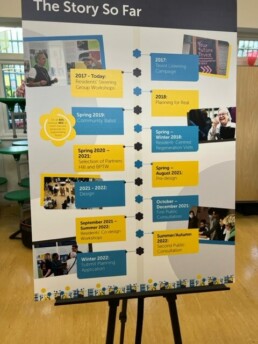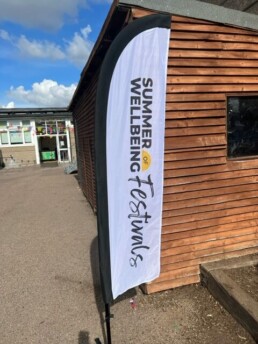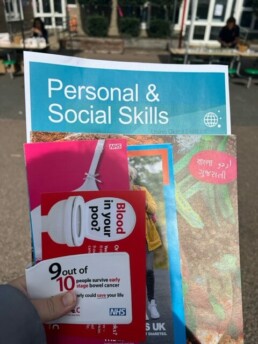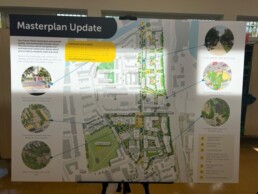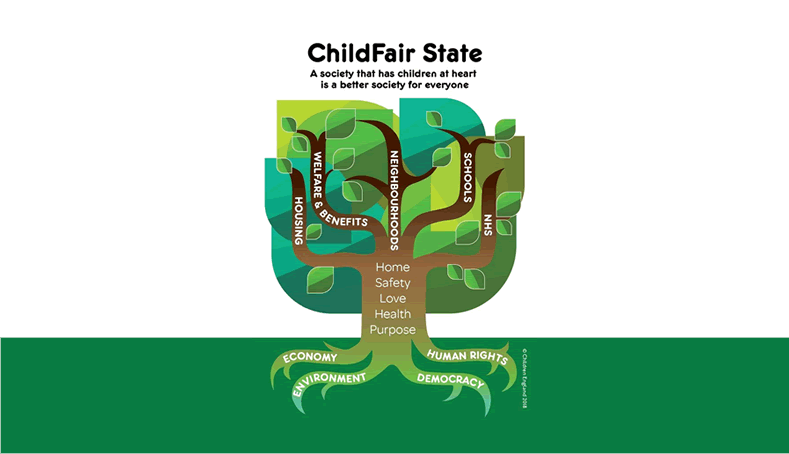Child Poverty in London: a societal problem calls for community-led solutions (Part 1)

Our Research and Learning Officer, Emily, discusses three questions on the issue of child poverty in London. This piece is split across three blog posts:
- What is child poverty?
- What’s the state of child poverty in London?
- How do we end child poverty?
What is child poverty?
The very fact that children experience poverty across London reflects the failings of British society to support its youngest members. Children are experiencing poverty because their guardians don’t have enough resource to meet their basic needs. Despite their care givers’ best efforts to protect them, children in poverty can experience the stress and insecurity that stems from not having enough to meet essential needs and some children even take on the practical or emotional responsibility to help alleviate some of the worries of the adults in their household. Children don’t choose poverty. And they can’t choose to end it. They rely on adults in their community, both local and national to make the changes necessary to ensure they, as children, get what they need.
Relative poverty is defined as a household income that is 60% below the median income. While children are in poverty across the country, they may not experience it in the same way. In London, housing costs and childcare costs mean that children in London are more likely to live in unsuitable accommodation and fewer access early years education whereas in other parts of the country, the challenges may be high travel costs or their adult carers experiencing difficulty finding work.
What causes it?
The simple reason for what causes poverty is that household income isn’t enough and is far below the average of many other households. The much more complicated answer is that inadequate income can be the result of an inability to work, poor health, disability, discrimination or unexpected change of circumstances or a combination of challenges that lead to income insecurity. Where it gets really complicated is that accessing adequate income is not a case of simply trying to secure more work because often suitable, paid work is not accessible, for example because of prohibitive childcare costs. This is where narratives around personal responsibility and shame can take root and spring life to inaccurate descriptions as to why some people have enough and others don’t.
Child poverty is caused by both indirect and direct policy decisions related to children. For example, financial budget reductions for schools, youth services and community organisations mean that children are cut off from the services meant to serve them specifically and in turn it’s only those who can afford to pay for those same services that get the high quality opportunities that help shape children’s present experiences to lead to privileged future opportunities. In addition, policies that impact wages, housing and service provision across the country mean that adults can’t access the jobs and support they need, which has a knock-on effect for children. In combination, these circumstances exacerbate inequality making a greater divide between those who can afford to pay extra and those who can’t afford the essentials.
What makes child poverty different?
One of the worst parts of child poverty is that it hurts people at a crucial time in their lives when poverty is integrated into their physiological systems. When their bodies and minds are developing rapidly, and their emotional regulation is dynamically maturing, the trauma that poverty inflicts has a lasting impact. While adults might feel the burden of responsibility, they also have more political influence as voters. Children do not. They can’t work, they can’t vote and they can’t always access the people with power and influence to change. So, they are made to wait and struggle.
How Poverty Feels
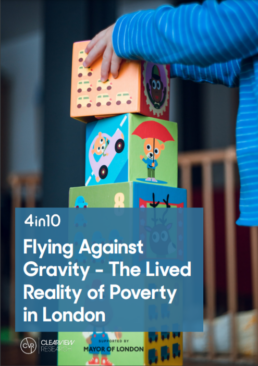
In 2021, 4in10 in partnership with the Greater London Authority commissioned ClearView Research to speak with Londoners to understand what poverty felt like since the Covid-19 pandemic had hit. What Londoners said helps paint a picture of the challenges that so many people face.
All of us across the city have ambitions and there is plenty of opportunity to go around, but it’s been ring-fenced for a small group of people leaving many with too little left. The report showed that with an inadequate social security system, many families found the challenge of gaining secure employment, suitable housing, affordable childcare and everyday costs out of reach. Despite having big dreams, many felt that they were fighting forces beyond their control, an experience compared to flying against gravity.
In 2023, with numerous strikes occurring on a regular basis, it’s clear that workers in many sectors feel they are at breaking point highlighting that the foundations are in need of repair. Basic transportation, health and teaching services are woefully underfunded and lacking investment for innovation and expansion. It’s worth revisiting this report to understand what families are facing today.
Families can’t strike, they have to keep up the fight despite recent data showing that low-income Londoners have faced 21% inflation over the last three years. Families are choosing between heating and eating and the prospect of focusing on career progression when your flat is mouldy and transportation is unaffordable and childcare is inaccessible is an impossible challenge.
What Londoners asked for in the report was for government to make the basics affordable. If childcare, cost of living bills and transportation were affordable then the possibility of families accessing better employment and housing that would enable them to thrive could come to fruition. This is what a good social security system does, it ensures we all have what we need through a social investment for us all. We need policies shaped by all of us to ensure no one gets shut out of decisions that affect them.
Revisiting this report from 2021 is worthwhile because its key findings still hold their weight. That is that poverty is something most of us are concerned about and 85% of us believe that politicians should do more about it.
With local elections just around the corner and London mayoral elections and a General Election on the horizon, it’s worthwhile thinking about making sure politicians hear from you that ending poverty warrants strategic policies. It must be a priority if communities are to thrive, and industries continue to expand providing income sources for Londoners. Flying Against Gravity shows the experiences of Londoners in first-hand accounts that remind us of the emotional toll that is unacceptable.
Together we can do more by demanding lasting change to ensure we all have what we need to soar.
Children with special educational needs and disabled children

4in10 organised a coffee morning in February 2023 that was jointly hosted by staff and parents at Marjory Kinnon School in Hounslow. Rochelle McIntyre, the Family Support and Community Outreach Worker facilitated the discussion and had invited her colleague Jo Stacey, Assistant Head Teacher, Key Stage 2 and Staff Governor as well as a parent to provide first-hand experience.
This mother shared her experiences as a single-parent and the challenges of caring for a child with autism. Throughout the group discussion, a few key costs were mentioned that demonstrate the challenge of parenting and educating children with a learning disability. These include:
- Changing dietary needs and specific food items being essential to meet the sensory needs of the child, these foods are often more expensive or difficult to predict and buy reduced
- Clothing and textures becoming uncomfortable leading to new purchases frequently
- High costs to attend a sensory appropriate gym, averaging £17.50 per visit which swallows up a high proportion of the Disability Living Allowance (DLA) that her son is entitled to
- Taxis across London for appointments as the underground is too overstimulating
- This parent shared that her son often strips off his clothes at home meaning its particularly important to keep the house warm enough, thus adding to the cost of utilities.
The emotional side for parents was also highlighted. A parent in attendance explained that working part time and taking coursework all had to stop because it just became too overwhelming for her and exhausting to keep up. Even when she was able to access a personal assistant, there were still costs associated with the PA taking care of her son or taking him out and about that limited how much her son could do with her PA. Thus, it felt like there were always limitations and challenges as to how much help she could get because the costs keep adding up.
Another parent of a child with autism shared her own experiences and emphasised that practical help is important, but the challenge of supporting and adjusting to the sensory needs of a growing child with autism is always there.
At 4in10, we want to listen to these experiences and share them with those who make decisions that impact children and their parents. We want to highlight the financial and emotional challenges that parents face and the impossible situations that parents with low-incomes encounter when caring for a child with a special need or disability. If you have other thoughts or experiences that you’d like to share, please do get in touch so we can support growing more awareness and social action to advocate for better support of children with varying needs and financial situations.
Research about young people designed by young people for young people
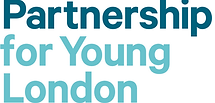
Reflections from Research and Learning Officer, Emily Barker, on an exciting new venture organised by one of our members and taking place across London.
Young Londoners Research Project
For those interested in youth-led research, I’ve got something to share! I came across a brilliant series of projects that our member, Partnership for Young London, is coordinating along with Rocket Science and Young Harrow Foundation. A total of nine research projects are taking place thanks to these partners working with the Greater London Authority who has commissioned ‘a new programme that will fund and support young people, their youth or support workers and their youth organisations to research young people’s views.’
Follow this link to learn more about the Young Researchers Programme and for a description of the nine exciting projects underway. The variety of projects speaks to the scope of creativity and talent of these young people. It’s a thrill to hear how passionate as well as thorough and insightful these young people are about putting in the work to develop new knowledge that will help improve the experiences of young Londoners.
When young people are involved in evaluating and improving the services aimed at them, it can help increase the reach and impact of these services on those who need it most. Many of the projects consider what barriers exist for young people who need to access additional support. Making steps to improve young people’s lives is a key strategy in mitigating the impact , both immediate and long term, of child poverty.
I am especially looking forward to hearing about the findings of the research projects in spring 2023! I can’t wait to learn from their analysis!
Visit to Summer of Wellbeing Festivals
On Saturday 24th September I was lucky enough to go to Poplar on behalf of 4 in 10 to see for myself the work that one of our members was doing.
Well One have been putting on a series of events between July and September called the Summer of Wellbeing Festivals and this was the last of them.
During this completely free to attend event I got to speak to a large number of different organisations offering advice on subjects as diverse as cancer screening and bike repair.
There were also loads of activities for children, again free, such as a bouncy castle, balance bikes and a personal highlight for me learning to make a flapjack – yum!
When I registered I was given a sheet with a layout of the event on it and entered into a prize draw (if I was able to get stamps from all of they key areas).
Following this map, next took me to the display which explained the proposals for the regeneration of Your future Teviot.
This was really interesting to study and the level of community engagement that has gone into this project was particularly good to see.
I then explored the health advice area and finally completed a survey on vaccine uptake.
Events such as these, as well providing key information about the future of our communities are much needed to help bring communities together and to provide help and advice.
I really want to thank Well One for the invitation and congratulate them on such a sucesfful event.
I’m looking forward to going again to any future events!
Maddie
Hello from our new Research and Learning Officer
I am so very excited to have joined 4in10 as Research and Learning Officer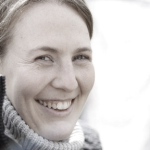 . My name is Emily Barker and I look forward to ensuring that 4in10 continues their amazing work of bringing together and providing support to London’s brilliant network of charities and individuals who are working to reduce the impact of child poverty across the city.
. My name is Emily Barker and I look forward to ensuring that 4in10 continues their amazing work of bringing together and providing support to London’s brilliant network of charities and individuals who are working to reduce the impact of child poverty across the city.
It’s a privilege to be part of a team working hard to support all of our members as we fight to end child poverty in London. Sadly, it feels like this winter will be an uphill battle after an already exhausting several years for us all in both our individual professional and personal lives. But in partnership, we can do so much more and our collective voice has the potential to demand permanent change in our capital.
So while this post serves as an introduction, it’s also an invitation. In my role, I want to provide our members with a balanced mix of events that fall under three main categories:
- Capacity building-to equip you with new tangible skills relevant to your work and organisational objectives
- Social Networking-to cultivate an active and supportive network of likeminded people working to respond to the growing inequality and demanding better for the future
- Information sharing-to provide clear, succinct summaries of recent policy changes or emerging research that fosters creative responses to complex problems
In addition, I will be facilitating some collaborative research with a few member organisations to ensure the voices of those with lived experience are centred in our calls to action of local and national leaders. This project is still being developed but would include a small research grant for participating member organisations.
If you would like to suggest future events or learn more about our future collaborative research project, please do get in touch to continue the conversation! Equally, I’d be very keen to visit your offices or attend your own events to learn more about your current work and immediate challenges.
I want to work together and ensure that the opportunities and information 4in10 provides is practical, relevant and not duplicating what’s available elsewhere. If there’s something you need or want to learn more about, you’re probably not the only one, so please share your ideas.
I look forward to meeting you digitally or in person over the coming months and thank you for all the work you do.
Government Holiday activities and food programme 2022

Holiday activities and food programme 2022 across London
The Government has provided local councils with some funding to allow them to fund free holiday childcare and food provision.
Full details about the program can be found here.
Around London each local council has spent the funding in different ways and supported different organisations so here at 4in10 we have attempted to gather them all together in one place.
Levelling Up White Paper: Why using London as a yardstick risks children everywhere
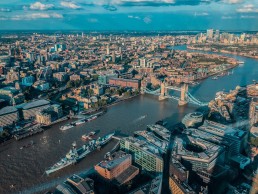
Levelling Up White Paper: Why using London as a yardstick risks children everywhere
In February, this year, the government released their long-awaited Levelling Up White Paper, a 300-page long publication covering everything from the history of the biggest cities in the world to twelve separate missions for the UK. By now, and a few months on from its publication, you may have read any number of analyses or opinion pieces on this unusual document.
At 4in10, London’s Child Poverty Network, amongst the myriad of missions and metrics, there were two key issues stand out as being of great concern:
- Child poverty in London is completely absent from the paper (the phrase ‘child poverty’ does not appear at all).
- London is used a yardstick for success for other regions, despite having the highest levels of inequality and poverty. The White Paper explicitly intends to replicate London’s economic model in other regions despite these facts. This risks the exacerbation of child poverty not just in London but in other areas identified as needing to be ‘Levelled Up’ (Middlesbrough, Blackpool, Newcastle, the Humber etc).
Child Poverty in London and Levelling Up
Although London is discussed in some sections of the Levelling Up White Paper, child poverty levels are not referenced. This is despite four in ten children in London currently living in poverty and nine of the ten local authorities with the highest levels of child poverty being located in London. If children in the capital, or elsewhere in the UK, are going hungry due to poverty – and the White Paper fails to mention – let alone address this – the phrase ‘Levelling-Up’ rings hollow. The White Paper does discuss the deprivation and lack of investment into many regions across the UK. However, it is possible for two truths to be present at once:
- Vast areas of the UK have experienced chronic underinvestment.
- London’s children are experiencing worsening poverty levels and increasingly deep levels of poverty.
It is true that some of London’s children do experience some advantages (but these tend to be limited to social mobility measures); a child on free school meals in London is twice as likely to attend university compared to those in the north of England. In London’s most deprived areas, nearly 90 per cent of secondary schools are either good or outstanding, compared with less than 50 per cent in deprived areas of the north. Transport spend per head has been higher in London for a decade (although this doesn’t always benefit poorer Londoners in outer boroughs); London transport spending per head was £864, compared with £379 in the north-west of England between 2009-2020. All of these facts are little compensation to the 12 children in a classroom of 30 who live in poverty in London. If one of the children in an East London classroom ends up going to Oxbridge, or gets a job at a top law firm, that is little compensation to the 11 others who still live in poverty. Similarly, the ability to get from Hackney (East London) to Thornton Heath (South West London), for as little as £1.65, means very little when the parent to the child pays (on average) £1,650 on rent per month in Hackney.
At 4in10, believe the Levelling Up agenda can, and should, address both regional underinvestment and child poverty rates in all areas of the country, including London. We should not pit children in one area against another (as the White Paper states itself; page xiv)– any child growing up in poverty in the United Kingdom is an avoidable tragedy.
There is a real risk that the high levels of poverty and child poverty, experienced in London and elsewhere, will be overlooked by national policy makers in light of the White Paper.
Replicating London’s Private Sector Productivity Model
“Typically, differences within UK regions or cities are larger than differences between regions on most performance metrics” (Levelling Up White Paper 2022: p27)
A significant part of the reason child poverty is overlooked by the Levelling Up White Paper is due to the fact the main objective of ‘Levelling Up’ is to reproduce the London’s levels of productivity in other regions of the UK, through processes of agglomeration. It is consistently implied, in the White Paper, that living standards will increase once the rest of the UK’s long standing productivity problems are resolved. In London, both as a whole unit and at local authority levels, productivity metrics are higher than other regions. Across the measures selected by the government as indicative of a productive area, Gross Value Added per hour, median gross weekly pay, and proportion of population with a Level 3+ qualification – London scores highly in comparison to other regions. This leaves London’s true picture of poverty somewhat obscured.
Using Gross Value Added (GVA), the favoured productivity measurement of the government, Tower Hamlets is the third most productive region in the country (ONS 2021). Therefore, Tower Hamlets has ‘Levelled Up’, right?
If you were to walk down in a street in Tower Hamlets, in the shadow of Canary Wharf, one in two families (55.8% – End Child Poverty Coalition: 2021) would be living in poverty; if you asked them how high GVA levels or the private sector productivity of the financial district has benefited them, they would struggle to give you an answer.
This gets to the heart of why we at 4in10 are alarmed that this model is being sought to be replicated elsewhere. Living standards, such as child poverty, in Tower Hamlets for example, would not be improved by a further increase in shiny new private sector buildings in the borough.
As a network organisation whose members have seen the impact of child poverty rising over the last decade, the use of London as a yardstick for success or model to be copied is highly concerning. It is not just concerning for children in London, but also for children in places like Leeds, Rotherham, and Middlesbrough, who are the primary focus of ‘Levelling Up’ narratives. Whilst ‘Levelling Up’ certainly means different things to different people, but we would all agree that an area has not levelled up whilst still having extremely high levels of child poverty.
The Equality Trust and New Economics Foundation have already flagged that the Levelling Up White Paper must focus on people, not just places. Research from the NPC (2022) shows that only 2% of the total levelling up funding is going on supporting social infrastructure so far, despite the public’s expectation that will Levelling Up tackle social issues. The public consider the most important aspects to an area being levelled up to be reduced homelessness (36%) and reduced poverty (36%).
However, the problems with the White Paper and child poverty levels in London run even deeper when contextualised against continuous unhelpful narratives:
How Can We Change The Narrative That London Doesn’t Need To Be Levelled Up?
After waiting a few months to see if these concerns would be addressed by policy makers, it is clear that we need an alternative narrative or frame to tell the true story of child poverty in London. Despite years of (sky) high child poverty rates in London, Westminster are simply not listening. No single statistic will provide a silver bullet to this problem, as:
- People outside of London either aren’t aware of the scale of child poverty in London, or they simply don’t believe the scale of inequality and poverty in London when presented with evidence.
- There is a sense of unfairness/grievance felt towards London from some parts of the UK; typically providing London with any public funding is unpopular.
- London is no longer a major political priority for either the national Conservative or national Labour parties
In light of these factors, we need urgently to find an alternative way to make the case for the 700,000 children living in poverty in the capital.
We want to work alongside our members, and anyone who shares our concerns about child poverty in London to help us tell the true story of its impact and challenge the prevailing narratives in the White Paper that prevent us from tackling it.
4in10's new Strategy Manager, Katherine Hill writes her first blog on why poverty is a human rights issue.
The right time for rights
The modern international human rights framework was born out of the chaos and trauma of the second world war. In the 1940s when the global community stood at a crossroads asking itself which way next, one response was the UN Declaration of Human Rights which sought to codify a set of universally held values: freedom, respect, equality, dignity and autonomy.
Over the past year this human rights framework, which to many in 21st century Britain had felt remote and was perceived by some as only benefitting groups at the margins of society, has become central to all our lives. The Government has been forced to take decisions which have curtailed our rights. The right to private and family life, the right to protest, the right to practise religion, have all been restricted in order to protect the right to life. Opinions about whether the correct balance has been struck between these rights have varied and many will argue that at points it has been wrong but the widespread acceptance of human rights as the right language for having the conversation has been striking. It has put those universal values centre stage once again.
As we look to the future, the challenge is shifting from protecting the right to life to the question of how we rebuild lives and livelihoods. That conversation again needs to be conducted firmly in the language of human rights and be rooted in the values they embody. It must be not only about civil and political rights, but also about how to protect the right to food, the right to work, the right to an adequate standard of living, the right to health, the right to education and the right to play. These rights are referred to as economic, social and cultural (ESC) rights and they are protected in international law in treaties such as the International Covenant on Economic, Social and Cultural Rights (IESCR). Protection for them in our domestic law is weaker although that has begun to change in some parts of the UK; Scotland has recently become the first country in the UK to directly incorporate the United Nations Convention on the Rights of the Child, which includes many ESC rights.
What has been clear for a long time and has been brought into even sharper focus by the pandemic is that our economic and welfare systems are not upholding these rights for everyone. The shocking child poverty figures published this week (25th March) are testament to the fact that too many in work do not receive a wage that provides an adequate standard of living and that the safety net which should protect this right for those not in work and in low paid work is broken. The result of this failure is that children and their families are denied the freedom and dignity that others enjoy.
The good news is that in some quarters the language of values and rights are already very much part of the conversation. Children England's Child Fair State young leaders are well ahead of the game and have done inspirational work, reimagining the welfare state in a way that put values back at the heart of the system. The original welfare state was developed in the same era as the international human rights framework but was not an overtly rights-based system. If we are to emerge from the pandemic a more equal society, free from child poverty, it is time to put that right.
My views on inequality and the upcoming London Mayoral Election by Alex Bax
Alex Bax, Chair of My Fair London has written a personal blog with his views on inequality and the upcoming London Mayoral Election.
Inequality in London almost doubled in the 1980s. It has stayed at this high level for the last thirty years.
We now have more billionaires than any other city in Europe, and more than another point in our history;
5% of Londoners own 50% of the wealth of our city. 50% of Londoners share only 5% of the wealth between them;
Homelessness has increased by 150% in the last ten years;
Child poverty has tripled in the last 40 years.
With the impending London election, now is the time to ask our mayoral candidates to make a commitment to reduce inequality.
In the foreword to his last manifesto, Sadiq Khan, London’s current mayor, said ‘For a child growing up on a council estate today, London is not the city of opportunity that it was for my brothers, my sisters and me.’ He is absolutely right, and the biggest underlying change that has made today’s London a much, much harder place for young people to get on, is the incredible increase in inequality that we have seen since 1979. To create a London that works for ‘all Londoners’, we must begin to reverse that 40 year drift to the extreme levels of inequality we all live with today, and the many small, medium and large insults that such an unfair society inflicts on every one us.
What we achieve in life is partly a function of our personal ambitions and interests, our capabilities and enthusiasms. But all our personal endeavour takes place in a context. The harsher the context in which we live the harder it is for personal qualities to overcome circumstance. A very unequal society, where money has become the defining characteristic of worth, is a very harsh environment for us all. Gross inequality makes it harder for every Londoner to live a full, free and fulfilled life. It makes life harder for the middle classes and for the poor, it most harms the chances of people at the very bottom, and even the rich are not immune from its impacts, as they retreat behind gates and security guards. If London’s mayor is to deliver on that promise to young Londoners growing up today, they must tackle inequality.
A wealth of international evidence shows that more equal societies have more social mobility. This is partly because the shape of more equal societies, the steepness of the social and economic gradient, is less. Each step up, or down the ladder is smaller, and because status anxieties are less, moves up or down are less psychologically difficult. We only have to look at the make-up of the current British cabinet to see how easily privilege begets privilege. The London housing market is a great illustration of how the ladder of advantage is being pulled up behind those lucky enough to have bought their home in the past. Today a young Londoner without the ‘bank of mum and dad’ faces a far harsher future than the young Sadiq Khan. Inherited wealth is back, and the privilege it brings is back too.
When Sadiq Khan was growing up in the seventies and early eighties London was a far more equal city. His formative years came at the end of a 60-year period during which Britain had become ever more equal. Since 1979 the gap between rich and poor has returned to levels not seen since before the First World War. 1970s London was not a perfect society, racism was endemic and gay rights non-existent. However lower levels of economic inequality meant young people were more likely to feel they could get on. With narrower economic gaps between people mutual respect and a sense of belonging was stronger. As inequality grew through the 1980s these ‘felt’ possibilities diminished, and at the same time the practical supports that any fair society should offer to people lower down the social scale were gradually eroded. Today, a family like Sadiq’s, with a bus driver as the main earner, would be incredibly fortunate to get a council flat. They would more likely live in private rented accommodation on an insecure lease, and little Sadiq’s education would have been interrupted by his family having to move house several times, and probably change school. His bus driver father’s pay has stagnated over 40 years. The increased wealth and productivity of the economy has been taken by the top 10 and top 1% of earners. Today Sadiq’s family would be in receipt of tax credits to help them make ends meet and would probably claim housing benefit to bridge the gap between their household income and the rent. As the children grew up and moved away the bedroom tax might force Sadiq’s parents to move again. Instead of the rent the Khan family pay going to a local authority, to invest in more housing or other services, today that tax payers’ money most likely goes to a private landlord through housing benefit. Frequent moves will have stressed Khan family relationships, and may also have made it difficult for his parents to send young Sadiq to the school of their choice, especially if richer neighbours have used their housing equity to move closer to a school that claims better results.
At school, status anxiety and a more competitive environment will have increased Sadiq’s chances of developing a mental health problem in his adolescent years, and the growing ‘social distances’ between social groups have made it less likely that young Sadiq has a group of friends from a range of backgrounds. Youth clubs, libraries, other public services accessible to all, but most useful to those with the least, have gradually been cut. For a young man from an ethic minority living on a council estate in south London to stay out of the way of gangs (where poor young people attack each other over the pettiest of sleights or perceived threats to social status) is a real challenge. One bright spot is that sustained investment in London’s state education system, with a focus on leadership and the quality of teaching, that started in the late 1990s, means that London’s schools do buck the trend nationally in raising the attainment of lower income children. However, if young Sadiq does well at school and wants to go on to university to pursue his dream of becoming a lawyer he and his family will face the prospect of a mountain of student debt.
Of course, for the real Sadiq his late teenage years and early adulthood played out during the 1980s, the decade that saw what was probably the most rapid increase in inequality that Britain has ever seen. The most corrosive, pernicious effects of inequality take time to have an impact so perhaps the young Sadiq Khan, his family and community in South London, continued to benefit from the high point of equality that was Britain before 1979.
Today’s young Londoners, especially those living on council estates, face a world far less generous, and far more unequal than those of Sadiq Khan’s generation. Living in a highly unequal society exposes young people to chronic social stress. This in turn acts to dysregulate key biological systems in our bodies (cortisol levels for example) leading to increased life-time chances of a wide range of long-term health conditions and psychological problems. Being exposed to high levels of inequality is seriously toxic, and just like air pollution it is all around us.
The deep inequalities in our society set the scene for the lives of today’s young Londoners. Fairer societies have lower levels of crime, greater social mobility, lower levels of obesity and mental illness, higher levels of trust and higher and more fairly distributed life expectancy. But high inequality is also a political choice. The UK has been far more equal in the recent past, and is far less equal than many other successful developed economies. I challenge the new mayor to recognise the harm inequality does to the city and put economic fairness at the heart of their programme.


